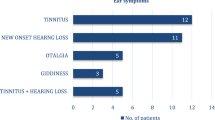Abstract
Otosyphilis is a rare but important cause of sensorineural hearing loss and dizziness, because this hearing loss can be reversed by early diagnosis and aggressive treatment. Moreover, HIV may alter the course of otosyphilis and hasten the development of otosyphilis by reducing host cellular immunity. We report the case of a 35-year-old HIV-infected patient with bilateral fluctuating sensorineural hearing loss and bilateral total vestibular loss caused by otosyphilis. We include a discussion of the relationship between otosyphilis and HIV infection.



Similar content being viewed by others
References
Birdsall HH, Baughn RE, Jenkins HA (1990) The diagnostic dilemma of otosyphilis. A new western blot assay. Arch Otolaryngol Head Neck Surg 116:617–621
Gleich LL, Linstrom CJ, Kimmelman CP (1992) Otosyphilis: a diagnostic and therapeutic dilemma. Laryngoscope 102:1255–1259
Hendershot EL (1973) Luetic deafness. Laryngoscope 83:865–870
Hungerbuhler JP, Regli F (1978) Cochleovestibular involvement as the first sign of syphilis. J Neurol 219:199–204
Johns DR, Tierney M, Felsenstein D (1987) Alteration in the natural history of neurosyphilis by concurrent infection with the human immunodeficiency virus. N Engl J Med 316:1569–1572
Katz DA, Berger JR (1989) Neurosyphilis in acquired immunodeficiency syndrome. Arch Neurol 46:895–898
Kobayashi H, Mizukoshi K, Watanabe Y, Nagasaki T, Ito M, Aso S (1991) Otoneurological findings in inner ear syphilis. Acta Otolaryngol [Suppl] 481:551–555
Linstrom CJ, Gleich LL (1993) Otosyphilis: diagnostic and therapeutic update. J Otolaryngol 22:401–408
Linstrom CJ, Pincus RL, Leavitt EB, Urbina MC (1993) Otologic neurotologic manifestations of HIV-related disease. Otolaryngol Head Neck Surg 108:680–687
Marcusen DC, Sooy CD (1985) Otolaryngologic and head and neck manifestations of acquired immunodeficiency syndrome (AIDS). Laryngoscope 95:401–405
Mohr JA, Griffiths W, Jackson R, Saadah H, Bird P, Riddle J (1976) Neurosyphilis and penicillin levels in cerebrospinal fluid. JAMA 236:2208–2209
Morris MS, Prasad S (1990) Otologic disease in the acquired immunodeficiency syndrome. Ear Nose Throat J 69:451–453
Sando I, Orita Y, Miura M, Balaban CD (2001) Vestibular abnormalities in congenital disorders. Ann N Y Acad Sci 942:15–24
Smith ME, Canalis RF (1989) Otologic manifestations of AIDS: the otosyphilis connection. Laryngoscope 99:365–372
Yoder FW (1975) Penicillin treatment of neurosyphilis. Are recommended dosages sufficient? JAMA 232:270–271
Young H (1998) Syphilis. Serology. Dermatol Clin 16:691–698
Author information
Authors and Affiliations
Corresponding author
Rights and permissions
About this article
Cite this article
Song, J.J., Lee, HM., Chae, S.W. et al. Bilateral otosyphilis in a patient with HIV infection. Eur Arch Otorhinolaryngol 262, 972–974 (2005). https://doi.org/10.1007/s00405-005-0934-1
Received:
Accepted:
Published:
Issue Date:
DOI: https://doi.org/10.1007/s00405-005-0934-1




